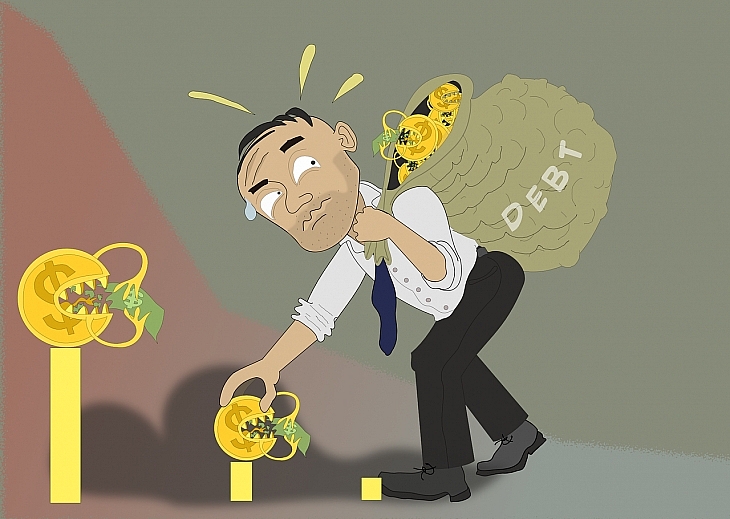Consumer finance to combat black credit
 |
| Consumer finance fight with black credit |
Actual situation of consumer credit
Speaking at the seminar about solutions to repel black credit, which took place in the head office of VIR on March 15, Dr Can Van Luc, chief economist of BIDV, said that the Vietnamese financial market has been developing at a tremendous pace in the past 20 years. The financial depth shown by the size of credit amounted to VND7.2 quadrillion ($313.04 billion), equivalent to 131 per cent of the GDP by the end of 2018.
 |
| Dr Can Van Luc, chief economist of BIDV |
Consumer lending was formally authorised in Vietnam in 1995, and has grown strongly in the last 10 years, promoting economic growth (including consumption, production, and services), increasing access to credit, reducing the rate of black credit, and limiting cash payments. Besides, there are still problems that need to be solved.
Consumer finance is a part of consumer credit. The Vietnamese consumer finance market was born in the late 1990s, when commercial banks began integrating such loans into their retail banking products. However, the market has only really began to develop since 2007, when consumer finance companies joined the market.
By the end of 2012, the total outstanding loans of consumer lending were about VND230 trillion ($10 billion), accounting for 8 per cent of the economy’s total credit balance. By the end of 2018, consumer credit balance reached about VND1.4 quadrillion ($60.87 billion – six times as much as in 2012), accounting for about 19.4 per cent of total outstanding loans in the economy (according to the State Bank of Vietnam).
Of the total consumer credit balance by the end of 2018, outstanding loans of consumer finance companies accounted for about 8 per cent (equivalent to $4.78 billion), consumer credit from commercial banks was 88 per cent, and other financial institutions such as FinTech and were 4 per cent.
According to StoxPlus 2018, the three main financial companies currently controlling the credit market are FE Credit with 48 per cent, Home Credit with 17 per cent, and HD Saison with 10 per cent. Other companies like Prudential Finance, Toyota Finance, JACCS, Mirae Asset, and McCredit, among others also actively participate in the market.
“With a population of more than 95 million, incomes rise along with the economy – and so does demand for loans and access to lans. The consumer credit market has great potential to develop in the future,” said Tran Kim Anh, deputy director of the General Economic Department under the Central Economic Commission.
Nguyen Tu Anh, deputy director of the Monetary Policy Department at the SBV, said that consumer credit will continue to develop strongly in the upcoming time due to the rapid growth of the middle class as well as Vietnam’s much-lauded medium-term economic potential.
 |
| Nguyen Tu Anh, deputy director of the Monetary Policy Department, SBV |
Why is black credit still attractive?
The service for consumer credit is growing day by day to meet the needs of many people. However, the strength of consumer credit is not enough to repel black credit problems. Regarding this situation, Tu Anh of SBV commented that, “Customers of consumer credit are normally people whose ability to assess and manage risk is low but desire to change their life. This makes them easy targets for debt traps.”
Lawyer Tran Minh Hai, managing director of Basico Law Firm, expressed the opinion that black credit is currently stronger than legal credit because it is simply there to meet the demand. People always have a demand to borrow money and the most obvious place to go is banks and finance companies. However, the current regulations in Circular No.39/2016/TT-NHNN and No.43/2016/TT-NHNN on consumer lending remain barriers to meet this demand.
 |
| Lawyer Tran Minh Hai, managing director of Basico Law Firm |
These circulars tie the hands of credit companies. For instance, a person borrows money from another individual to buy a motorbike, then needs another loan to repay the first debt. In this case, financial and banking companies cannot lend money because this demand is not within the tenets of Circular No.39 and No.43.
“Meanwhile, black credit meets any borrowers’ needs, even when the borrower does not specify the reason. This is the outstanding strength of black credit and also the reason why many people seek black credit,” said lawyer Hai.
In addition, black credit is unfettered by conditions and procedures that apply to legal credit, making it far more accessible.
Developing non-bank financial institutions
Nguyen Thanh Phuc, deputy general director of FE Credit, said that banks by themselves fall short of the full demand among consumers not only in Vietnam but also in the world, especially when it comes to retail loans mobilised in a short time. Therefore, in order to meet consumers’ demand in Vietnam in a healthy and legal way, it is necessary to develop a system of non-bank financial institutions.
 |
| Nguyen Thanh Phuc, deputy general director, FE Credit |
However, according to Phuc, consumer finance institutions are often misunderstood as black credit because people do not have enough information about consumer finance. Consumer finance is established under the provisions of law and granted certificates and operation licenses under the management and supervision of the SBV.
The loan contracts of consumer finance institutions are clear and transparent. Meanwhile, black creditors normally lend without any contract with high interest rates contrary to the provisions of the law.
Trinh Ba Viet Xo, head of the strategic partner department of Home Credit, said that to effectively co-ordinate with management agencies to repel black credit, from an enterprise perspective, consumer finance companies need to have a comprehensive competitive strategy in five areas: increase accessibility to people; improve understanding of safe credit for people; improve product quality; enhance customer experience; and create more add-on services. Risk insurance for consumer creditors is extremely necessary, especially for low-income borrowers to avoid risks.
 |
| Trinh Ba Viet Xo, head of strategic partner department, Home Credit |
According to Viet Xo, consumer finance companies have been actively contributing to solving the demand for safe loans, contributing to repelling black credit and promoting comprehensive finance in Vietnam.
In addition, Dang Tuyet Dung, Visa’s country manager for Vietnam and Laos, said that as consumer finance grows, confidentiality appreciates as a concern among customers and financial institutions.
 |
| Dang Tuyet Dung, Visa’s country manager for Vietnam and Laos |
Nowadays, biotechnology helps identify customers’ faces by using the picture on their identity cards, ensuring 100 per cent authentication without having to come to the bank. However, there are still rules to bind customers and they must still sign the original signature with the bank. This is also a part to consider when and how to approach technology to help customers access consumer finance services faster.
What the stars mean:
★ Poor ★ ★ Promising ★★★ Good ★★★★ Very good ★★★★★ Exceptional
Related Contents
Latest News
More News
- PM orders investment model for North–South high-speed rail (December 22, 2025 | 17:43)
- First members of Danang International Finance Centre revealed (December 22, 2025 | 17:39)
- Securing capital and efficiency for Vietnam’s 2026-2030 growth ambitions (December 17, 2025 | 10:00)
- Driving double-digit growth through green and circular transformation in Vietnam (December 17, 2025 | 09:00)
- Vietnam bucking trend in the global M&A landscape (December 16, 2025 | 14:20)
- Vietnam’s green transition demands collective financial action (December 15, 2025 | 12:00)
- VIR workshop highlights capital and policy for sustainable development (December 15, 2025 | 11:00)
- National Assembly approves pilot mechanisms to accelerate major projects in Hanoi (December 12, 2025 | 11:29)
- Vietnam eases policy approval requirements, simplifies foreign and outbound investments (December 11, 2025 | 17:53)
- Unpacking new momentum in Vietnam’s M&A market (December 10, 2025 | 09:59)

 Tag:
Tag:

























 Mobile Version
Mobile Version